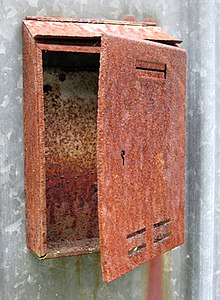This article needs additional citations for verification. (November 2013) |




Hot-dip galvanization is a form of galvanization. It is the process of coating iron and steel with zinc, which alloys with the surface of the base metal when immersing the metal in a bath of molten zinc at a temperature of around 450 °C (842 °F). When exposed to the atmosphere, the pure zinc (Zn) reacts with oxygen (O2) to form zinc oxide (ZnO), which further reacts with carbon dioxide (CO2) to form zinc carbonate (ZnCO3), a usually dull grey, fairly strong material that protects the steel underneath from further corrosion in many circumstances. Galvanized steel is widely used in applications where corrosion resistance is needed without the cost of stainless steel, and is considered superior in terms of cost and life-cycle. It can be identified by the crystallization patterning on the surface (often called a "spangle").[1]
Galvanized steel can be welded; however, one must exercise caution around the resulting toxic zinc fumes. Galvanized fumes are released when the galvanized metal reaches a certain temperature. This temperature varies by the galvanization process used. In long-term, continuous exposure, the recommended maximum temperature for hot-dip galvanized steel is 200 °C (392 °F), according to the American Galvanizers Association. The use of galvanized steel at temperatures above this will result in peeling of the zinc at the inter-metallic layer[citation needed]. Electrogalvanized sheet steel is often used in automotive manufacturing to enhance the corrosion performance of exterior body panels; this is, however, a completely different process which tends to achieve lower coating thicknesses of zinc.
Like other corrosion protection systems, galvanizing protects steel by acting as a barrier between steel and the atmosphere. However, zinc is a more electropositive (active) metal in comparison to steel. This is a unique characteristic for galvanizing, which means that when a galvanized coating is damaged and steel is exposed to the atmosphere, zinc can continue to protect steel through galvanic corrosion (often within an annulus of 5 mm, above which electron transfer rate decreases).
- ^ GalvInfo (August 2011). "GalvInfoNote / The Spangle on Hot-Dip Galvanized Steel Sheet" (PDF). GalvInfo. Archived from the original (PDF) on 2 March 2014. Retrieved 27 February 2014.